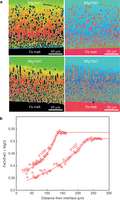December 13, 2012 report
New study suggests Earth's lower mantle penetrated by metallic blobs

(Phys.org)—Researchers from Yale University have found that molten iron is able to penetrate into rock samples in a unique way under certain conditions. Geophysicist Shun-ichiro Karato and student Kazuhiko Otsuka together have found that when molten iron is brought into contact with magnesium-iron oxide crystals under high pressures and temperatures, metal blobs form inside the crystals – suggesting that it might be possible that the Earth's lower mantle might consist of a similar metal heavy material. They present their findings in a joint paper published in the journal Nature.
The Earth, as most science students know, has three main parts: the crust, the mantle and the core. Scientists learn more about the makeup of the mantle and core by studying seismic waves sent through them, and studying the way electrical signals change as the pass through the different layers. Studies done over the years have led researchers to believe that the lower part of the mantle has been imbued with iron from the core. But, other research has shown that simple diffusion would not be sufficient to account for the amount of metal that appears to exist there, nor would other known infiltration processes. In this new research, the team suggests it got there by a means never before seen.
The researchers created a high pressure, heated environment where they caused samples of molten iron to come into contact with crystals of magnesium-iron oxide. After just a few minutes they noted that iron rich blobs of liquid began penetrating into the crystals. In their lab the penetration was just 100 micrometers, but the two suggest that in a much larger environment, such as where the Earth's core meets the mantle, such penetration could extend to 100 kilometers, offering an explanation of why the lower mantle appears to have so much iron in it. They suggest that the blobs form due to an instability that occurs in the concentration gradient of iron oxide in the crystal.
This new research may also help to explain what appear to be dense layers observed in other planets as well. But, because magnesium-iron oxide is rather rare in the Earth's mantle, new research will focus on finding other minerals that behave in the same way when exposed to molten iron.
More information: Deep penetration of molten iron into the mantle caused by a morphological instability, Nature 492, 243–246 (13 December 2012) doi:10.1038/nature11663
Abstract
The core–mantle boundary of Earth is a region where iron-rich liquids interact with oxides and silicates in the mantle. Iron enrichment may occur at the bottom of the mantle, leading to low seismic-wave velocities and high electrical conductivity, but plausible physical processes of iron enrichment have not been suggested. Diffusion-controlled iron enrichment is inefficient because it is too slow6, although the diffusion can be fast enough along grain boundaries for some elements. More fundamentally, experimental studies and geophysical observations show that the core is under-saturated with oxygen, implying that the mantle next to the core should be depleted in FeO. Here we show that (Mg,Fe)O in contact with iron-rich liquids leads to a morphological instability, causing blobs of iron-rich liquid to penetrate the oxide. This morphological instability is generated by the chemical potential gradient between two materials when they are not in bulk chemical equilibrium, and should be a common process in Earth's interior. Iron-rich melt could be transported 50 to 100 kilometres away from the core–mantle boundary by this mechanism, providing an explanation for the iron-rich regions in the mantle.
Journal information: Nature
© 2012 Phys.org















